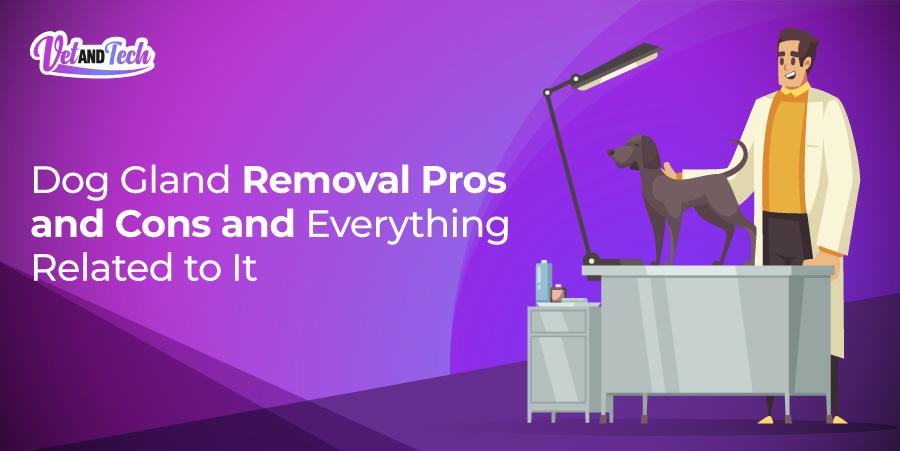Dog Gland Removal Pros and Cons and Everything Related to It
According to a survey by Banfield Pet Hospital, in the USA, anal gland removal surgery was performed in 3% of dogs seen at the clinics of small animal veterinarians.
Basically, glands are small, sac-like structures near the anus. They produce and secrete a foul-smelling fluid used for scent marking and communication between dogs.
Undoubtedly, anal gland removal dogs can be uncomfortable and painful; the decision to remove them should not be taken lightly.
In this blog, we will discuss all dog gland removal pros and cons. Besides that, we’ll look into alternative options for managing anal gland infection dog.
So keeping reading to get insights on all related factors.
Let’s get started with what the procedure includes!
What Does Canine Anal Gland Removal Include?
Before going to Dog gland removal pros and cons, it’s essential to understand the procedure.
Removing anal glands in dogs is a relatively simple surgery; however, it requires some preparation and post-operative care to ensure a quick recovery.
Let’s discuss the anal gland removal procedure step by step.
Pre-operative Preparation
Before the surgery, the veterinarian needs to evaluate and determine if anal gland removal is the best course of treatment for the affected small dog.
The evaluation may involve
- A minor physical examination
- Blood regulation &
- Some other essential diagnostic tests
If the surgery is necessary to carry out, the veterinarian will give the dog a full physical examination. It may include a complete blood count (CBC) and blood chemistry profile.
By doing that, the vet can ensure the compatibility of the dog's health with anesthesia.
Anesthesia
The first step of the procedure is administering anesthesia to the dog.
This ensures that the dog is comfortable and pain-free during the surgery. Usually, veterinarians use general anesthesia for this procedure.
Surgical Procedure
Once the dog is asleep and the surgical site is shaved and cleaned, the vet will make an incision near the anus and carefully remove the anal glands.
The exact technique may vary depending on the dog's anatomy and the veterinarian's preference.
Sometimes, vets use a scalpel or scissors to remove the glands.
In other cases, a laser may be helpful in removing the glands. As a result, it reduces bleeding and minimizes healing time.
After removing the glands, the veterinarian will close the incision with sutures or staples.
Post-operative Care
After the surgery, monitoring the dog closely is essential to ensure a smooth recovery.
The veterinarian may prescribe pain medication and antibiotics to help prevent infection and manage discomfort.
Additionally, the dog may need to wear an Elizabethan collar. This helps prevent them from licking the incision site.
The veterinarian will provide detailed instructions on how to care for the dog post-surgery, which can be related to
- Diet
- Exercise
- Medication &
- General care
Dog Gland Removal Pros and Cons
Anal sacculectomy is a procedure with both benefits and some potential risks.
Dog Gland Removal Pros and Cons Comparison Table
|
Dog Gland Removal Pros |
Dog Gland Removal Cons |
|
Prevention of anal gland problems |
Potential risks and complications associated with surgery |
|
Elimination of unpleasant odor |
High cost of the procedure |
|
Reduction of discomfort and pain in dogs |
Impact on Dog's digestive system |
|
Improved quality of life for dogs |
Potential for recurrence of anal gland problems |
Let’s discuss these pros and cons one by one.
Pros of Dog Gland Removal
There are several potential benefits associated with dog anal sacculectomy. The pros of dog gland removal are as follows.
• Prevention of Anal Gland Infection Dog
One of the most significant advantages of dog anal gland surgery is preventing anal gland infection.
These infections are usual in dogs and can occur when the glands become impacted.
Impacted glands can cause discomfort and pain for dogs and lead to infection and even abscesses.
By anal gland removal dogs, one can prevent these problems, and the dog can get rid of the associated discomfort and pain.
Additionally, if a dog has a history of chronic anal gland problems, canine anal gland removal may be necessary to prevent future issues.
• Elimination of Unpleasant Odors
Another benefit of anal sacculectomy is the elimination of unpleasant odors.
Anal gland fluid has a strong, unpleasant odor that can be quite potent. Actually, dogs use this fluid for communication and marking purposes.
However, it can result in an unpleasant smell that lingers in the home and on the dog's fur.
After removing the glands, the dog will no longer produce this fluid and annoying odor.
• Reduction of Discomfort And pain in Dogs
In addition to preventing anal gland problems and eliminating unpleasant odors, dog gland removal can reduce dog discomfort and pain.
Dogs with chronic anal gland issues can experience significant pain and discomfort. This develops into abscesses, which require surgical intervention.
Through sacculectomy, these problems can be eliminated, and the dog can live a more comfortable and pain-free life.
• Improved Quality of Life
Last and above all, gland removal improves a dog's overall quality of life.
Anal gland infections can cause severe discomfort and pain for dogs, resulting in a lower quality of life.
If the dogs undergo a gland removal procedure, they will get rid of pain and discomfort, resulting in a better higher quality of life.
Dog Anal Gland Removal Cons
While dog gland removal has many benefits, some drawbacks and risks should also be considered.
Common canine anal gland removal cons are as follows.
• Potential Risks And Complications Associated With Surgery
One significant con of dog gland removal is the potential risks and complications associated with surgery.
In healthy dogs, these risks are relatively lower. However, they still need to be taken into consideration before going for the procedure.
The resulting complications may include
- Excessive bleeding
- Irreversible infection
- Adverse reactions to anesthesia
- Delayed sacculectomy recovery
• Dog Anus Gland Removal Cost
Another consideration is the cost of the procedure.
One should be well aware that dog gland removal can be costly, particularly if there’s an emergency or a specialist perform it.
The average cost of the procedure ranges from $1,000 to $7,000.
Adding to it, the cost can be even higher if the dog experiences complications during or after the surgery, requiring additional veterinary care and monitoring.
• Anal Gland Removal Dogs Impact on Digestive System
The impact on the dog's digestive system is also a concern with dog gland removal.
The anal glands play a role in the dog's digestive process, and their removal can result in changes to bowel movements and digestive health.
After the procedure, some dogs may experience
- Diarrhea
- Constipation
- Other digestive issues
Therefore, it is important to monitor the dog's digestive health closely after the surgery.
Moreover, pet owners should make necessary adjustments to their dog’s diet or medication.
• Potential For Recurrence Of Anal Gland Problems
After the surgery, there is still a chance for the recurrence of anal gland problems.
While removal can prevent future issues with impacted or infected glands, there is still a risk of other anal gland problems, such as abscesses or tumors.
Apart from that, some dogs may continue to exhibit symptoms of anal gland issues, such as scooting or licking the anal area.
Alternative Options For Dog Anal Gland Surgery
.jpg&v=1684156691)
While dog gland removal may be necessary in some cases, alternative options can also help manage and prevent the problems.
Some of the potential alternative options for dog anal sacculectomy include
- Diet and exercise changes
- Regular expression of anal glands
- Use of supplements and natural remedies
Let’s discuss them one by one.
Diet And Exercise Changes
Diet and exercise changes can play a significant role in preventing and managing anal gland problems.
A high-fiber diet can promote a dog’s regular bowel movements. Resultantly, this can prevent constipation, minimizing anal gland issues.
Similarly, regular exercise can help to promote healthy bowel movements and reduce the risk of anal gland infections.
It’s important that owners should consult with their veterinarian to determine the best diet and exercise plan for their dog.
Regular Expression Of Anal Glands
Regular expression of anal glands is another option for managing anal gland issues in dogs.
This involves manually expressing the glands to empty them of fluid and prevent impaction or infection.
This procedure can be performed at home; however, it is important to ensure it is done correctly to prevent injury or infection.
The best way is to consult a veterinarian or a professional groomer to learn how to perform the procedure safely and effectively.
Use Of Supplements And Natural Remedies
The use of supplements and natural remedies can also be helpful in preventing dog anal gland problems. Some supplements, such as probiotics and omega-3 fatty acids, can help to promote digestive health and reduce inflammation in the dog’s anal area.
Besides that, some natural remedies such as witch hazel or aloe vera can help soothe the anal area and reduce discomfort. However, before giving any kind of remedy to the dog, consultation with a veterinarian is crucial.
Looking for more non-surgical solutions? Check out this simple guide on Dog Gland Removal Pros and Cons.
To Conclude
From this guide to dog gland removal pros and cons, it’s evident that anal gland removal dogs can offer several potential benefits.
However, it is crucial to consider the associated risks and complications with surgery.
Additionally, alternative options can prove valuable to manage and prevent anal gland problems.
The best option is to consult a veterinarian to determine the most effective course of action.
For more comprehensive guides on vet learning and veterinary procedures, explore our vet resources page. We are dedicated to offering well-researched and accurate data on any topic in veterinary medicine.
FAQs
What are the signs of anal gland problems in dogs?
The common signs include scooting or dragging their rear end on the ground and licking or biting the anal area. The dogs also feel discomfort or pain when sitting or defecating, leaving a foul odor.
Can anal gland problems be prevented without surgery?
Yes, it’s possible to prevent anal gland problems without surgery. The methods may include feeding your dog a high-fiber diet, and ensuring their exercise expressing anal glands regularly. Supplements and natural remedies will also help.
How often should a dog's anal glands be expressed?
The frequency of anal gland expression can vary depending on the dog's breed, size, and overall health. Some dogs require expression every few weeks, while others only need it occasionally.








